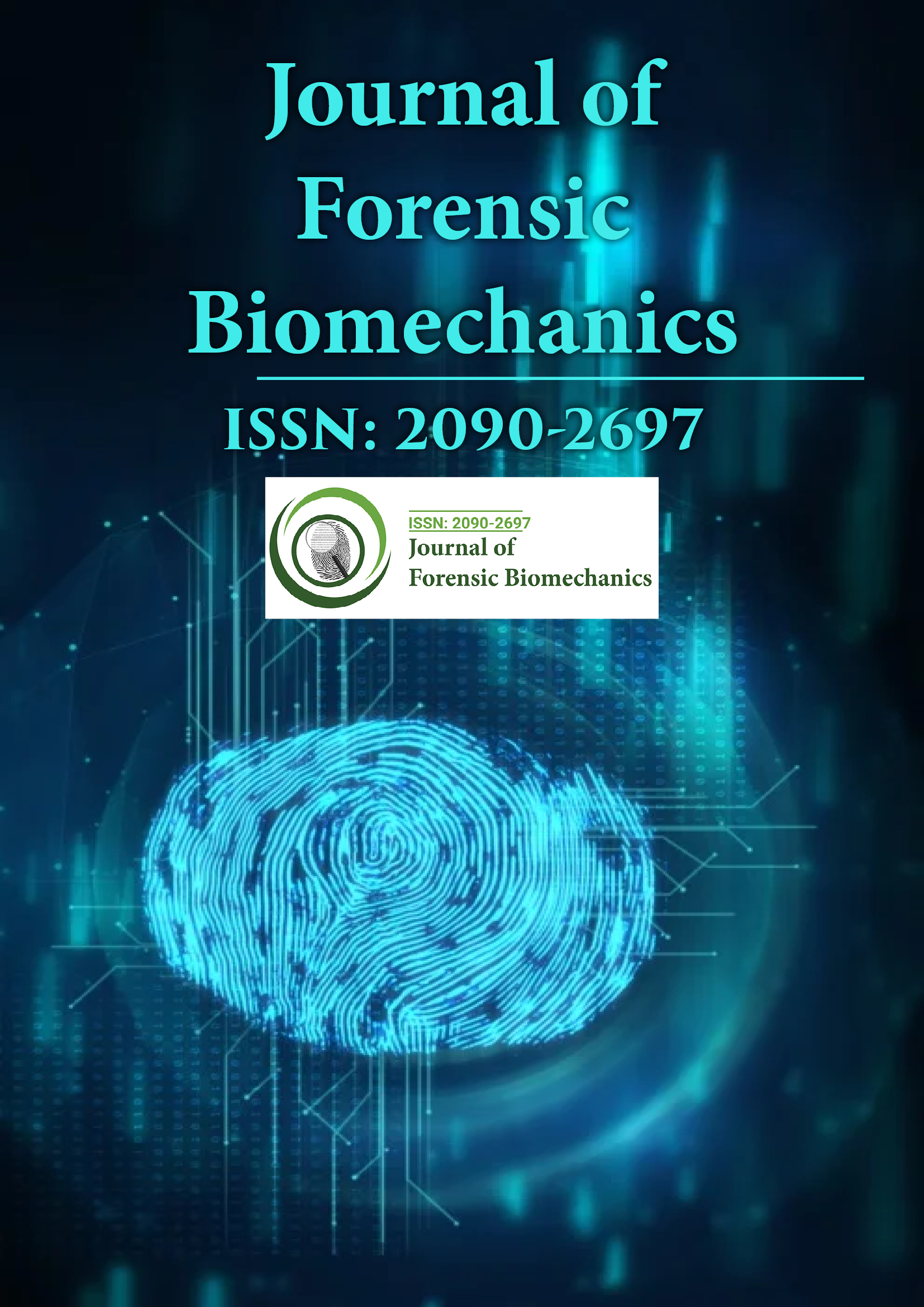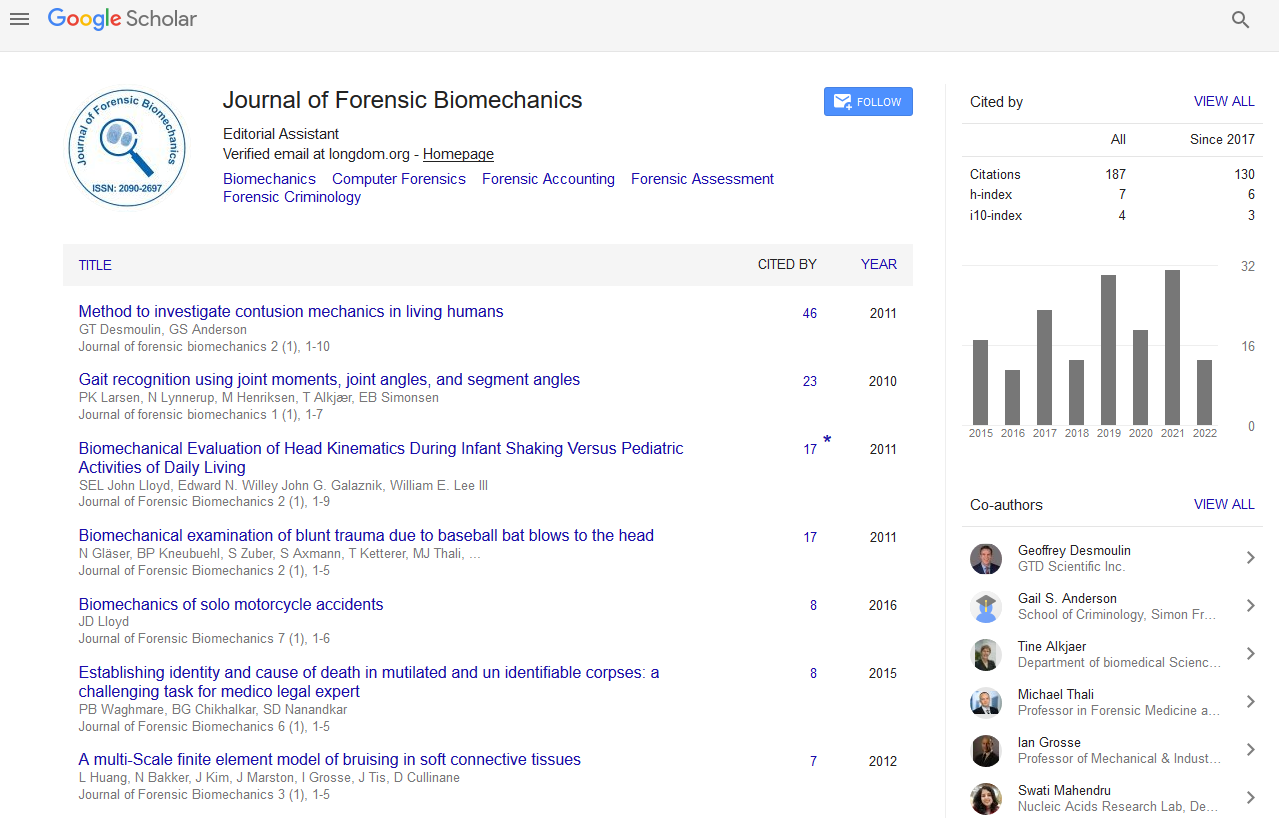Indexed In
- Genamics JournalSeek
- SafetyLit
- Ulrich's Periodicals Directory
- RefSeek
- Hamdard University
- EBSCO A-Z
- Geneva Foundation for Medical Education and Research
- Euro Pub
- Google Scholar
Useful Links
Share This Page
Journal Flyer

Open Access Journals
- Agri and Aquaculture
- Biochemistry
- Bioinformatics & Systems Biology
- Business & Management
- Chemistry
- Clinical Sciences
- Engineering
- Food & Nutrition
- General Science
- Genetics & Molecular Biology
- Immunology & Microbiology
- Medical Sciences
- Neuroscience & Psychology
- Nursing & Health Care
- Pharmaceutical Sciences
Perspective - (2025) Volume 16, Issue 1
Vehicle Accident Biomechanics: Analyzing Injury Mechanisms
Kevin Kara*Received: 01-Jan-2025, Manuscript No. JFB-25-28536 ; Editor assigned: 03-Jan-2025, Pre QC No. JFB-25-28536 (PQ); Reviewed: 17-Jan-2025, QC No. JFB-25-28536 ; Revised: 24-Jan-2025, Manuscript No. JFB-25-28536 (R); Published: 31-Jan-2025, DOI: 10.35248/2090-2697.25.16.516
Description
Vehicle accidents are a leading cause of injury and death universal, making the study of injury biomechanics essential in understanding the mechanisms behind these injuries. Injury biomechanics examines how forces during collisions affect the human body, providing insights that enhance vehicle safety designs, improve restraint systems, and inform medical responses. Injury biomechanics involves analyzing how mechanical forces such as acceleration, deceleration, and impact interact with the body's tissues and structures. The severity and type of injuries sustained in vehicle accidents depend on factors including the magnitude and direction of forces, the body's position at the time of impact, and individual anatomical differences. To simulate human responses in crash scenarios, researchers utilize Anthropomorphic Test Devices (ATDs), commonly known as crash test dummies. These dummies replicate human dimensions, weight distribution, and joint articulation, allowing for the measurement of forces and accelerations experienced during collisions.
Data collected from ATDs guide the development of safety features such as airbags, seatbelts, and vehicle crumple zones. Before the advent of ATDs, cadaver studies provided valuable data, but ethical considerations and variability limited their use. The development of standardized dummies has since become integral to automotive safety testing. The position of occupants during a crash significantly influences injury outcomes. Out-of- Position (OOP) occupants those not in the standard upright and forward-facing posture face increased injury risks. For example, passengers reaching for objects or unbelted individuals during sudden braking may assume positions that compromise the effectiveness of safety systems. Studies have shown that even lowspeed impacts can cause severe injuries, such as disc herniation or lumbar fractures, in OOP occupants. Understanding these scenarios is crucial for designing adaptive restraint systems that protect occupants regardless of their position during unforeseen events. Children involved in vehicle accidents exhibit distinct injury patterns due to their anatomical and behavioral characteristics. Waddell's triad describes a common pattern in pediatric pedestrians struck by vehicles:
• Femoral Shaft Fracture
• Intra-thoracic or Intra-abdominal Injuries
• Contralateral Head Injury
This triad occurs as the vehicle's bumper impacts the child's leg, causing a femur fracture, followed by torso injuries from the hood or fender, and finally, a head injury on the opposite side as the child falls. Recognizing this pattern aids in prompt diagnosis and treatment, underscoring the need for protective measures like child-specific restraints and traffic safety education. Beyond physical testing, computational modeling has emerged as a powerful tool in injury biomechanics. Finite Element Analysis (FEA) allows researchers to create detailed virtual models of the human body to simulate and analyze injury mechanisms under various crash conditions. These models can account for individual variability, such as age, sex, and pre-existing health conditions, providing personalized insights into injury risks.
Computational approaches complement physical testing, offering cost-effective and ethically sound methods to enhance vehicle safety designs. In conclusion, injury biomechanics serves as a cornerstone in comprehending how vehicle accidents inflict harm on the human body. By dissecting the forces at play and the body's responses, this field informs the continuous improvement of vehicle safety systems, ultimately reducing injury severity and saving lives. Perspective.
Citation: Kara K (2025). Vehicle Accident Biomechanics: Analyzing Injury Mechanisms. J Forensic Biomech. 16:516.
Copyright: © 2025 Kara K. This is an open-access article distributed under the terms of the Creative Commons Attribution License, which permits unrestricted use, distribution reproduction in any medium, provided the original author and source are credited

